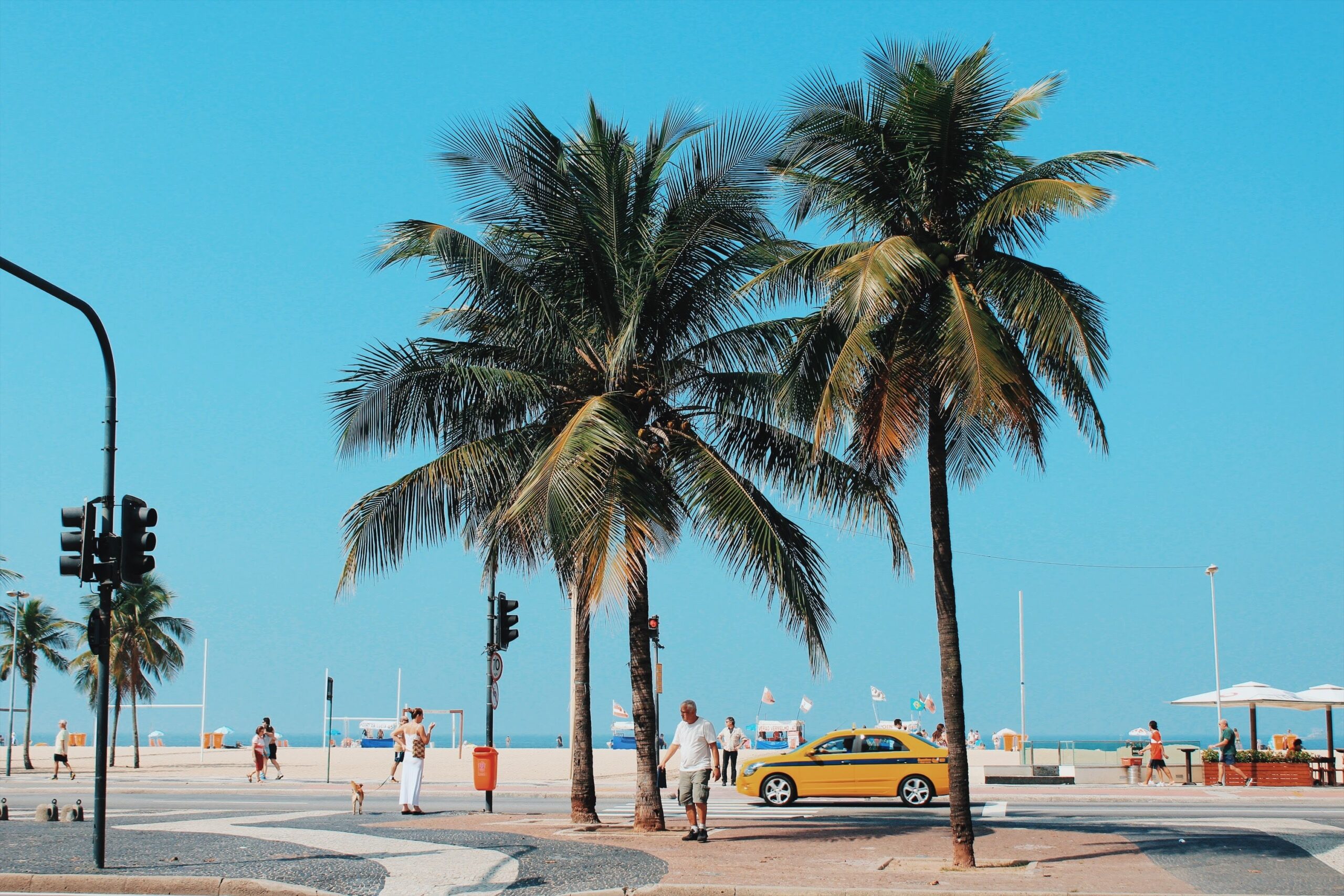Rio de Janeiro is a seaside city in Brazil. It is famous for its beaches and the iconic Christ the Redeemer statue on top of Mount Corcovado. Brazil’s culture is known for its ethnic diversity and penchant for celebration, so travelers are in for a treat. Rio de Janeiro is one of the most visited South American cities and it has plenty to offer tourists. Along with its gorgeous views that seem almost unreal, Rio de Janeiro has an array of popular attractions that are unique to the beachfront city.
Known to locals as “Cidade Maravilhosa,” which translates to the “wonderful” or “marvelous city,” Rio de Janeiro certainly lives up to its nickname with its lively atmosphere. The natural environment of Rio is spectacular and is one of the most sought after features of the area. The landscape is dramatically diverse and has mountains surrounded by lush forests, large bays, the Amazon Rainforest, beaches, lagoons and of course, the cityscape. Rio is an important destination for Brazil’s culture and hosts many popular attractions that are world famous. Carnival is one example of the cultural attractions fostered by the city. Carnival is held every year in Rio and is considered the biggest carnival in the world. It is a festival of Brazil that has vibrant colors, dance and music throughout the streets (as well as millions of people).
Since Rio de Janeiro has so much going for it, safety can be a concern with the amount of people that visit. Rio is a large economic and cultural hub so the city can be overwhelming with the millions of domestic and foreign tourists that travel to see the city every year.
Learn more about the safest locations, travel tips and when to visit Rio de Janeiro.
Official Travel Advisories
According to the U.S. Department of State travel advisory, travelers who plan to visit Brazil should exercise increased caution. Urban areas have an increased crime rate, especially at night. So, it is wise for travelers to keep tabs on crime in their area and only enter approved areas. Some border regions of Rio de Janeiro are considered level four, which is a high risk area that should not be traveled to. In particular, the Department of State cautions against using the municipal buses because of an increased risk of crime. Similarly, tourists are strongly cautioned to avoid entering into “informal housing developments” also known as favelas because of the higher crime rate in these districts.
Is Rio de Janeiro Safe for Tourists and Solo Travelers?

Rio de Janeiro is generally considered safe to visit. The city has over 6.7 million residents and is a sizable destination, so it is no surprise that some travelers question its safety levels. Although Rio is relatively safe for tourists, it has a bad reputation due to film depictions and some dangerous areas. Safety is not a monolith in Rio de Janeiro, so the neighborhood that travelers stay in is of utmost importance.
Leme, Copacabana, Ipanema and Leblon are some of the best neighborhoods that tourists can stay in during their time in Rio. All of these areas are near attractions and are considered safe. Leme is a quaint place and is more serene while Leblon is one of the more expensive areas. Both Copacabana and Ipanema offer travelers luxury accommodations that have beachfront rooms. Ultimately, many people who frequent Rio prefer to stay in Copacabana since it is safe and is conveniently located near the beach, public transportation and plenty of nightlife.
Violent crimes occur but are not common (or at least are not common enough to impact the majority of tourists). The crimes tourists are most likely to experience are of the petty variety such as phone theft or pickpocketing. However, while this can happen in Rio, that can be avoided by tourists exercising caution.
Common Scams to Be Aware of in Rio de Janeiro
No country is immune to scams, especially ones that target unsuspecting tourists — and Rio is no exception. The most common scams center around pickpocketing and overcharging unsuspecting tourists. Overcharging scams include overpriced tour packages to see Christ the Redeemer or taxis taking unnecessarily long routes or not revealing the price until after reaching a traveler’s destination. Avoid this by using transportation apps where the price is clearly posted before getting in the car.
Meanwhile, beaches are ripe for scams that require beachgoers to include food and drink as part of beach chair or umbrella rentals. Similarly, people offering items for sale will often overcharge especially when using a credit card for payment. This leaves the unsuspecting tourist facing sticker shock when the credit card bill comes in later. Avoid this scam by refusing to pay with a card and instead only using cash.
And another scam people should be mindful of is the diapers trick. This one plays to a person’s better nature as a woman holding a child asks tourists to help her buy diapers and milk for her child. Conveniently, she knows exactly which store to go to for the purchase. In truth, she has an agreement with the shopkeeper and earns a commission for every unsuspecting mark she brings to the store.
How to Stay Safe in Rio de Janeiro

For beach goers, Rio is an ideal destination. But, a visit to the water can be the last time visitors see their possessions if they are not careful. In Copacabana and Ipanema particularly, tourists should keep an eye on their possessions and never leave things unattended. Pickpocketing, theft and scams are generally what foreigners should worry about in Rio de Janeiro. Travelers should be careful at night too and avoid walking alone, since that may make them more susceptible to dodgy activities. These types of petty crimes have led to an increased police presence in popular tourism areas so that visitors do not fall victim.
Similarly, always confirm pricing before agreeing to taxi rides or making purchases. This aids in avoiding sticker shock and being the victim of a scam. Finally, opt for ride hailing apps over randomly accepting taxi rides in the street.
Where to Stay in Rio de Janeiro
There’s an area in Rio de Janeiro known as the accommodation area which is where most of the hotels, bed and breakfasts, and even hostels are located. The best areas tend to be West, South, and Downtown Rio. In particular West Rio was most recently built up after the 2016 Summer Olympics. Beach goers should focus on the West since the better beaches such as Grumari, Prainha, Barra, and Recrio are located there.
However, if tourist destinations are the priority, skip the West since it can translate to long transit times upwards of three hours round trip to see Christ the Redeemer. The bulk of the known tourist destinations are spread between the South and Centro. The South is nice for nightlife fans that also still want to be reasonably close to the beach. Great walkable and safe neighborhoods like Gloria, Santa Teresa, Catete, Botafogo, and Laranjeiras are highlights here.
Best Times To Visit Rio de Janeiro

The best times to visit Rio de Janeiro are dependent on the traveler. Some tourists love the ambiance of Carnival and prefer to be a part of the festivities, even with Rio full of people. To catch Carnival, travelers should visit Rio in February or March. The dates for the festival change each year, so travelers should check Rio Carnival’s website for insight.
Weather
The seasons of Rio de Janeiro are opposite of both Europe and the U.S. because it is below the equator, so travelers should be careful and note that difference. December to March has warm summer weather and is also the rainy season. This means that visitors who want to sunbathe on the beach may have to take a chance on what the weather will be like. Regardless of this weather gamble, this time also has higher prices and larger crowds.
To stay safe and avoid the downsides of that season, travelers can visit between September and October or April and June. These time periods are perfect to enjoy a less populated, calmer and safer Rio de Janeiro. The weather is usually moderate with sunny days, clear skies and a little rain. Rio de Janeiro has a tropical climate, so travelers do not have to worry about extremely cold weather (with winter occurring between June and August).
People Also Ask
Are Rio beaches clean?
After many years dealing with sewage, trash, and even industrial pollution, Rio’s beaches are clean and safe for swimming.
Can you drink the water in Rio de Janeiro?
Yes, you can drink the water in Rio de Janeiro. The tap water is safe there.
Is Uber available in Rio de Janeiro?
Yes, Uber is available in Rio. This makes a better alternative for tourists who can avoid being up-charged by unscrupulous taxi drivers.
Is Rio de Janeiro safe for tourists?
While no locale is going to be completely crime-free, Rio de Janeiro is considered generally safe for tourists if you stick to tourist districts. Avoid wandering into favelas or walking in poorly lit areas at night. Be aware of your surroundings and exercise common sense.
Should You Visit Rio de Janeiro?
For many U.S. citizens, Rio de Janeiro is an attractive destination that’s a plane ride away thanks to many non-stop routes connecting the U.S. to Brazil. As with any trip, exercising caution and being smart about surroundings and valuables can go a long way towards ensuring a person doesn’t become a victim of crime. Because Rio de Janeiro is located in the Southern Hemisphere, the best times to travel are in September and October, as well as April through June.





